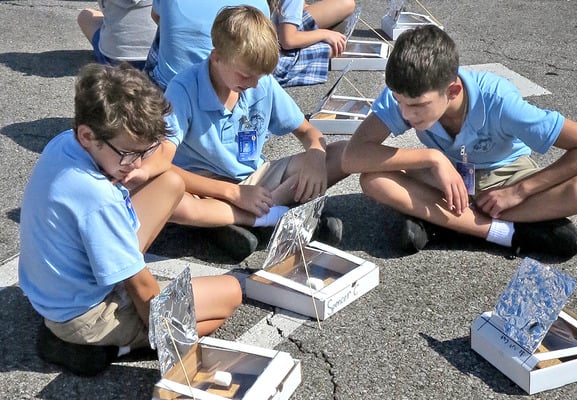
A platform that encourages healthy conversation, spiritual support, growth and fellowship

NOLACatholic Parenting Podcast
A natural progression of our weekly column in the Clarion Herald and blog

The best in Catholic news and inspiration - wherever you are!
State-provided science labs provide hands-on, educational fun at St. Christopher
-

Pictured above: St. Christopher fifth graders test out solar ovens they had built in their science lab, determining if the sun’s radiant energy could melt their s’mores. It did! (Photo by Beth Donze; additional photos can be viewed on the Clarion Herald’s Facebook page)
By BETH DONZE
Clarion Herald
A recent science lab completed by sixth graders at St. Christopher School began with a simple question: “What is a resource?”The answer: something that satisfies a need.
When it comes to satisfying our energy needs, the sixth graders learned, those “resources” typically fall into two categories: renewable energy – the kind that never runs out – such as the endless power that can be harnessed from the wind, sun, water and the earth’s own geothermal heat; and nonrenewable energy – finite sources of power that include uranium-driven nuclear energy and “fossil fuels,” such as oil, natural gas and coal, derived from plants and animals that died even before dinosaurs roamed the earth.
“The earth had to create fossil fuels, and it took it a very long time,” said Robin Narez, the lab’s presenter, telling the sixth graders that retrieving some fossil fuels involves digging “17 football fields” down into the earth’s crust.
The lab – one of three that unfolded Oct. 24 at the Metairie school, was presented by Narez and Leigh Ann Smith, visiting educators from the Louisiana Department of Natural Resources’ State Energy Office. The duo travels across the state to provide free, hands-on, energy-related labs to any elementary or high school that requests them. (see the end of this story for more information on the labs and other services available to schools.)
Self-guided learning
After the overview on resources, Narez and Smith shared ways the fifth graders could lower their energy consumption. For example, they could take shorter showers and rewear unsoiled clothes rather than just throwing them into the laundry after one use. Instead of watching TV or turning on the lights at home, they could go outside to play or read a book.
“Or know what you want from the fridge before you open it; that is energy conservation,” Narez suggested.
To reinforce the difference between renewable and nonrenewable sources of energy, the sixth graders played a game called “Candy Collector,” using straws to move M&Ms and skittles into separate bowls. The skittles, representing units of renewable energy, could be reused in subsequent rounds of the game, whereas the M&Ms – nonrenewable energy – could not be included in the students’ trove of candy and disappeared after a single use.
Energy-related labs were offered to two other grades by the Energy Office educators during their visit to St. Christopher’s campus:
• First graders read the story “Energy Island” and made miniature windmills. “Did you know that you can use a windmill to make electricity?” Narez asked the youngsters.
• After a presentation on the radiant energy of the sun, the school’s fifth graders constructed individual solar ovens by attaching aluminum foil to a small pizza box and took their ovens outside. When strategically positioned, the reflective ovens captured and intensified solar energy and melted the s’mores inside.
Variety of lab offerings
“I find that teaching kids this way makes such a difference – when you reinforce knowledge with an activity, it stays with them,” said Narez of the Energy Office’s visiting lab program that debuted in 2018 and was particularly appreciated during lockdown, when content was delivered virtually and assisted the many teachers “who were burned out and needed a break.”
In addition to the three labs presented at St. Christopher, other energy-themed labs are available from the Energy Office in both in-person and virtual formats: “Exploring Oil” probes how oil is formed and has students making their own oil wells (using different sizes of straws to “extract” liquids, such as chocolate milk); in the “Solar Activities” lab, students make art on sunprint paper and bracelets with solar beads; “Saving Energy” includes age-appropriate presentations, worksheets, coloring sheets and energy audits; “Energy Circuits” introduces students to the science of electricity and challenges them to build a working circuit; and, in the “Energy House Challenge,” they design and build energy efficient houses using kits provided by the Energy Office.
The state Energy Office provides all instruction and lab materials (other than food items used in some of the labs) at no cost to schools. The office also offers free workshops and lesson plans to teachers who are seeking continuing education opportunities.
For more information on the state Energy Office’s programs for students and/or teachers, email [email protected] or [email protected].




